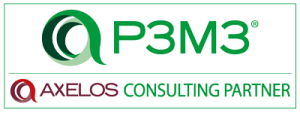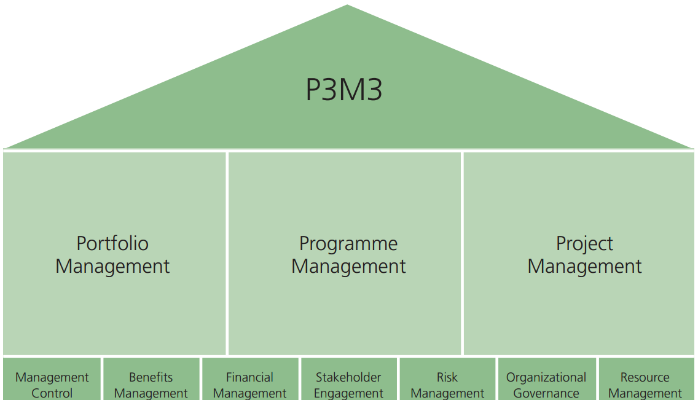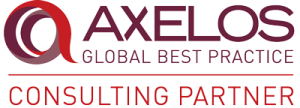Articles
What’s P3M3? What are the benefits for organizations?


What’s P3M3? What are the benefits for organizations?
Definition of P3M3
P3M3 (Portfolio, Program and Project Management Maturity Model) is developed Axelos. P3M3 provides a framework that organizations can use to benchmark their current performance and plan for improvement when managing and delivering change. This allows organizations to determine their strengths and weaknesses in delivering change. Besides, helping organizations assess the relationship between their portfolios (PfM3), Programs (PgM3) and projects (PjM3).
Briefly, this model helps managing an organization’s portfolios, programs and projects by breaking down the process of managing into a hierarchy of smaller key processes. This hierarchy is known by the name (Key Process Area) or (KPA). The seven Key Process areas are used within the five levels:
- Management Control
- Benefits Management
- Financial Management
- Stakeholder Engagement
- Risk Management
- Organization Governance
- Resource Management.


The structure of P3M3 (Source: Axelos, 2015)
There are five levels of maturity that organizations can be awarded against, namely:
- Awareness level, in which top management should realize the need to use a process-based approach.
- Repeatable Process level, when managers will be taking the lead on a number of the initiatives.
- Defined Process level, in which managers should document all processes.
- Managed Process level, is specified by behavior and processes that are quantitatively managed.
- Optimized Process level, when organization will dedicate efforts to optimize its quantitatively managed processes to take into account predicted business needs and external factors.
What makes this Maturity Model widely used in many worldwide corporations and organizations is that it enables them to evaluate what they have of capabilities. This is to be helpful when the organization aims to make a plot or a road-map to improve the performance and achieve the determined goals.
Reasons to obtain P3M3
- To discover capability and determine which area to concentrate on
- To diagnose systemic weaknesses and eliminate root causes
- To benchmark capability against other organizations
- To Certify capability through independent assessment
- To priorities improvement initiatives
The difference between self-assessment and full assessment
There are two options to conduct an assessment. They are self-assessment (two levels) or a full (independent) assessment. The table below provides a summary of the criteria for selecting your preferred approach for the assessment. Table 1 below presents the comparison between 3 types of assessments.
| Criteria | Self-assessment (available at two levels) | Full assessment – certification | Full assessment – further diagnostic |
| Approach | Completed by an individual or group within the organization using the online self-assessment toolkit | Completed by a P3M3 consultant external to the organization using the full assessment toolkit and overseen by an AXELOS consulting partner | Completed by a P3M3 consultant external to the organization using the full assessment toolkit and overseen by an AXELOS consulting partner |
| Depth analysis | Three attribute statements per perspective per level | Thread level assessment, 10–13 per level, depending on scope | 25–50 attribute statements per perspective per level, depending on scope |
| Cost | Low to high depending on scope and approach. Generally has a lower cost than a full independent assessment | Medium as approach is predefined | Low to high depending on scope and approach |
| Objectivity | Low | High | High |
| Credibility | Low | High | High |
| Timescale | Shorter | Medium | Longer |
| Enables robust improvement plan | No | Limited (unless undertaken at the same time as a further diagnostic assessment) | Yes |
| Comparison with other organizations, or with earlier baseline | No (yes at the enhanced level) | Yes | Yes |
Source: Axelos, Introduction to P3M3, 2015
How does the assessment help organization plan their improvements?
A P3M3 assessment provides information, analytical results and useful comparisons with peer organizations that are willing to share their results to leverage improvement in performance. It allows you to develop your improvement plan through four steps by identifying the context, Where are you today? Where do you want to be? Did you get there?
P3M3 accredited consulting companies can offer three types of assessments as the following
- Project Management Maturity Assessment ‐ P1M3
- Program (including Project) Management Maturity Assessment ‐ P2M3
- Portfolio (including Program and Project) Management Maturity Assessment ‐ P3M3
The certificate awarded after an organization has applied the maturity model in one of their models (Program, Project or Portfolio) following the 5 levels. To gain the certificate, the organization need to provide the following evidence/steps:
- Initial scoping meeting to decide the maximum maturity level to be assessed
- Application form submitted to AXELOS Ltd.
- Detailed desk study of key documentation
- One to one interviews (minimum 15; depending on number of concurrent projects)
- Production of a Capability Assessment Report
- Submission of evidence and recommendation for certification to AXELOS Ltd.
The difference between P3M3 and OPM3
OPM3 is Organizational Project Management Maturity Model created by Project management Institute (PMI) but no longer under its support. In P3M3, there are 5 levels, while it’s 4 sequential stages of process improvement in OPM3 which are: standardize, measure, control and continually improve. Both models share the fields they operate in (Projects, Programs and Portfolios). In addition, P3M3 offers reports by stages, while OPM3 provides comprehensive reporting only.


Bakkah Inc. is accredited as AXELOS Consulting Partner (ACP). Bakkah offers full-assessment by providing consultation, framework and assessment for organizations, which aim to use P3M3 Maturity Model in order manage their portfolio, programs or projects and put in place their improvement plans. We provide our clients with guidance to gain the P3M3 certification (valid for three years).
Bakkah team for training and consulting



.png)

.png)